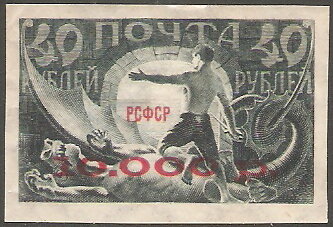Stamp: Triumph of Revolution, CARMINE OVERPRINT (Russia 1922)
Triumph of Revolution, CARMINE OVERPRINT (Russia 1922)
10 February (Russia ) within release 1st Definitive Issue of RSFSR - Surcharge goes into circulation Stamp Triumph of Revolution, CARMINE OVERPRINT face value 10,000 Russian ruble
| Stamp Triumph of Revolution, CARMINE OVERPRINT in catalogues | |
|---|---|
| Michel: | Mi: RU 175cIIIy |
Stamp is square format.
Carmine overprintAlso in the issue 1st Definitive Issue of RSFSR - Surcharge:
- Stamp - Agriculture and Industry, surcharged face value 5,000;
- Stamp - Agriculture and Industry, surcharged face value 5,000;
- Stamp - Agriculture, surcharged face value 5,000;
- Stamp - Agriculture, surcharged face value 5,000;
- Stamp - Agriculture, surcharged face value 5,000;
- Stamp - Agriculture, surcharged face value 5,000;
- Stamp - Agriculture, surcharged face value 5,000;
- Stamp - Agriculture, surcharged face value 5,000;
- Stamp - Agriculture, surcharged face value 5,000;
- Stamp - Industry, surcharged face value 5,000;
- Stamp - Industry, surcharged face value 5,000;
- Stamp - Triumph of Revolution, BLACK OVERPRINT face value 10,000;
- Stamp - Triumph of Revolution, BLACK OVERPRINT face value 10,000;
- Stamp - Triumph of Revolution, BLACK OVERPRINT face value 10,000;
- Stamp - Triumph of Revolution, RED OVERPRINT face value 10,000;
- Stamp - Triumph of Revolution, RED OVERPRINT face value 10,000;
- Stamp - Triumph of Revolution, RED OVERPRINT face value 10,000;
- Stamp - Triumph of Revolution, CARMINE OVERPRINT face value 10,000;
Stamp Triumph of Revolution, CARMINE OVERPRINT it reflects the thematic directions:
Animals are multicellular, eukaryotic organisms of the kingdom Animalia (also called Metazoa). All animals are motile, meaning they can move spontaneously and independently, at some point in their lives. Their body plan eventually becomes fixed as they develop, although some undergo a process of metamorphosis later on in their lives. All animals are heterotrophs: they must ingest other organisms or their products for sustenance.
A dragon is a magical legendary creature that appears in the folklore of multiple cultures worldwide. Beliefs about dragons vary considerably through regions, but dragons in Western cultures since the High Middle Ages have often been depicted as winged, horned, and capable of breathing fire. Dragons in eastern cultures are usually depicted as wingless, four-legged, serpentine creatures with above-average intelligence. Commonalities between dragons' traits are often a hybridization of feline, reptilian, mammalian, and avian features. Some scholars believe large extinct or migrating crocodiles bear the closest resemblance, especially when encountered in forested or swampy areas, and are most likely the template of modern Asian dragon imagery
Reptiles are tetrapod (four-limbed vertebrate) animals in the class Reptilia, comprising today's turtles, crocodilians, snakes, amphisbaenians, lizards, tuatara, and their extinct relatives. The study of these traditional reptile orders, historically combined with that of modern amphibians, is called herpetology. Because some reptiles are more closely related to birds than they are to other reptiles (e.g., crocodiles are more closely related to birds than they are to lizards), the traditional groups of "reptiles" listed above do not together constitute a monophyletic grouping (or clade). For this reason, many modern scientists prefer to consider the birds part of Reptilia as well, thereby making Reptilia a monophyletic class.
A sword is an edged, bladed weapon intended for manual cutting or thrusting. Its blade, longer than a knife or dagger, is attached to a hilt and can be straight or curved. A thrusting sword tends to have a straighter blade with a pointed tip. A slashing sword is more likely to be curved and to have a sharpened cutting edge on one or both sides of the blade. Many swords are designed for both thrusting and slashing. The precise definition of a sword varies by historical epoch and geographic region.




